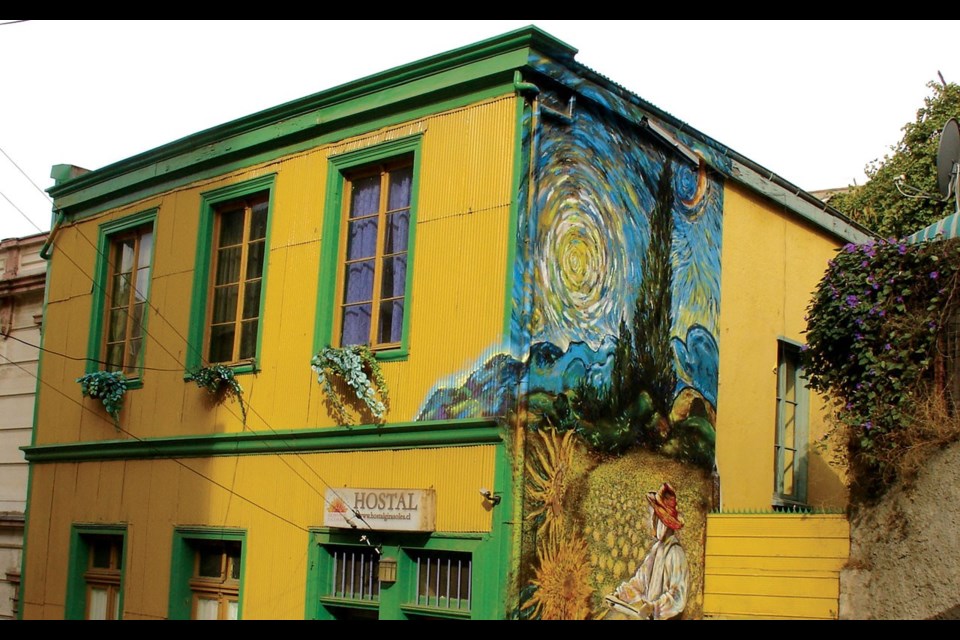Valparaiso's hills are alive with the sight of art.
When you wander the steep streets of Valparaiso, Chile you might wonder if you have stepped inside a Dr. Seuss-ian landscape.
The gritty port city is a series of cerros, or hills, that required architectural creativity to trounce topography. It is a curious concoction of brightly coloured, centuries'-old mansions tilting against dilapidated colonial-era apartment buildings; crooked stairways leading up to a saturated-blue sky; and creaky funicular lifts, which the World Monument Fund declared an endangered historical treasure. The twisty promenades provide panoramic views over a glittering sea, hence Valparaiso's moniker, the Jewel of the Pacific.
Valpo, as it's affectionately called by locals, is also known as the South American capital of street art; graffiti artists and muralists come from around the world to leave their marks on walls here, making for a unique and vibrant art walk.
My husband and I decide to start at the hill-top house of Nobel-Prize winning poet, political activist and diplomat Pablo Neruda. We are fit, so we felt we could handle the 2.5-kilometre hike uphill from the port. But we take a taxi because we aren't sure how to get there even after consulting a map, and we aren't sure which funiculars are operational should we need a lift. Valpo once had 30 ascensores, constructed more than 100 years ago. Today only a handful work.
As soon as we arrive at La Sebastiana (named for its original owner, whom Neruda dubbed a poet in wood) on Cerro Bellavista, we know it will live up to the hype. The narrow, multi-storied home echoes the city's eccentricities.
Best of all, unlike the historic houses of many writers—where you can only peer at old typewriters from the doorway or, worse, through smudged windows—you can roam freely here. An excellent audio guide provides colourful commentary on the quirky objects that fill each of the house's five floors: vividly coloured glass, nautical knickknacks, antique maps, a stuffed flamingo in a globe hanging from the ceiling.
One floor hosts a bar with vibrant pink walls and a bathroom that only the brave used, since a lattice door provided little privacy. Apparently, Neruda only drank wine and whisky but had cocktails on offer to liven up his frequent fetes. He always spent New Year's Eve here to watch the fireworks over the harbour.
There is an antique Parisian carousel horse in the round living room along with a round fireplace that Neruda designed, and an old leather chair he called "the cloud" because it offered him a good view of the tilting streets to the sea.
On the top floor, Neruda's study is filled with books, his old desk and even some of his green pens (he wrote in green because it is the colour of hope). The amazing 180-degree view should have been distracting. But given his prolificacy, it was clearly an inspiration instead.
Most touching, for me, is the bedroom. In the closet, there are pairs of his wife's shoes and an elegant long white coat. Her brush and powders still sit on the dressing table. Matilde was Neruda's third wife—and the love of his life. She never returned to the house after he died. Instead, she lived out her days at their house in Santiago, which Neruda named La Chascona, Chilean slang for untamed hair, after Matilde's red locks.
It's reminiscent of how he described Valparaiso: "...how absurd you are. You haven't combed your hair, you've never had time to get dressed, life has always surprised you."
Ready for such surprises, we leave the house to meander circuitous streets lined with rainbow-painted houses, flowering bushes flopping over fences and laundry flapping frantically on balcony clothes lines.
Some streets feel lonely, though we are accompanied by friendly stray dogs and countless cats arrogantly whisking their tails against our legs as they slink by. On other streets, artists lean against overlooks, trying to capture the view on their sketchpads.
It is impossible to go straight down. We turn a corner to find galleries featuring hip and provocative art (I buy an intriguing piece and talk to the artist on the phone to barter the price; later ,she emails me a long explanation of her inspiration), shops selling local fashions and courtyard cafés. We stop at one for succulent seafood.
Best yet, it is a visual feast—the most spectacular street art I have ever seen. From vandalistic tags to fantastical scenes that have been created by collaborating artists. From tiny intricate paintings to three-storey-high murals in every hue of the Crayola 64 pack.
It all started as a form of protest during the Pinochet dictatorship. Now, the local government promotes street art culture, and many businesses hire artists to paint their storefronts. Pay in Bellavista isn't high since it's such sought after space, but it's an honour to display here.
It is glorious, but gritty. Perhaps that's why visual and literary artists have long loved living here.
As for us, we adjourn to the "garden city" of Vina del Mar—a short bus ride away—for the evening. We are there to stroll glamourous boulevards lined with pretty palaces and walk the posh promenade.
But that's next week's story.
(By the way, if you didn't know that Seuss was also a painter, check out his piece Cat Detective in the wrong part of town: drseussart.com/secretandarchive/cat-detective-in-the-wrong-part-of-town.)




